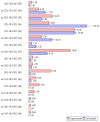The Structure of Storage Triacylglycerols of Mature Seeds of Lunaria rediviva L., a Hyperaccumulator of Very Long-Chain Monounsaturated Fatty Acids, from the Perspective of Statistical Distribution Theories and New Insights Based on Simple Calculations
- PMID: 40006871
- PMCID: PMC11859942
- DOI: 10.3390/plants14040612
The Structure of Storage Triacylglycerols of Mature Seeds of Lunaria rediviva L., a Hyperaccumulator of Very Long-Chain Monounsaturated Fatty Acids, from the Perspective of Statistical Distribution Theories and New Insights Based on Simple Calculations
Abstract
This article represents the first consideration of the peculiarities of the fatty acid (FAs) composition and structure of storage triacylglycerols (TAGs) of the relict plant Lunaria rediviva L. The composition of storage TAGs was found to comprise 21 individual FAs, with an unsaturated FA content of 96.8%. Additionally, monounsaturated acids with a very long chain (VLCFAs), specifically C20:1-C24:1, constituted over 60% of the total FAs. The ethylene bond position isomers of unsaturated FAs were accurately identified and the presence of unusual isomers, including 20:1Δ13, 22:1Δ15, and 24:1Δ17 acids. Furthermore, the unusual minor 24:2Δ15,18 acid was identified and characterised for the first time. The pathways of the mentioned VLCFA's biosynthesis have been proposed. The distribution of FA acyls between the sn positions of triacylglycerols was found to be highly specific. Thus, VLCFAs exclusively acylate the α positions of the carbon atoms of the glycerol residue of the TAG molecule (sn-1 and sn-3 positions), while unsaturated C18 acids exclusively acylate the β-carbon atom (sn-2 position). The composition of the molecular species of TAGs was analysed using a calculation method based on the Vander Wal model and by RP-HPLC-ESI-MS. A significant discrepancy from the statistical model was observed, indicating a preference for the formation of symmetrical TAGs, such as sn-1,3-dierucoyl-2-oleoyl-glycerol and related molecular species. This observation led to the formulation of a hypothesis regarding the potential existence of at least two specialised enzyme isoforms involved in the biosynthesis of such TAGs via the Kennedy pathway, exhibiting unusual substrate specificity. Consequently, this plant can be regarded not only as a producer of unusual molecular types of triacylglycerols but also as a source of genetic material for the search of genes encoding the aforementioned enzymes with unusual substrate specificity.
Keywords: Lunaria rediviva; RP-HPLC-PDA/ESI-MS; Vander Wal model; mature seeds; positional-species composition; storage oils; triacylglycerols; very long-chain unsaturated fatty acids.
Conflict of interest statement
The authors declare no conflicts of interest.
Figures






Similar articles
-
Separation of regioisomers and enantiomers of triacylglycerols containing branched fatty acids (iso and/or anteiso).Electrophoresis. 2021 Sep;42(17-18):1832-1843. doi: 10.1002/elps.202000320. Epub 2021 Jan 6. Electrophoresis. 2021. PMID: 33332630
-
Delta5-olefinic acids in the seed lipids from four Ephedra species and their distribution between the alpha and beta positions of triacylglycerols. Characteristics common to coniferophytes and cycadophytes.Lipids. 1999 Aug;34(8):855-64. doi: 10.1007/s11745-999-0433-1. Lipids. 1999. PMID: 10529097
-
Separation of triacylglycerols containing allenic and acetylenic fatty acids by enantiomeric liquid chromatography-mass spectrometry.J Chromatogr A. 2020 Jul 19;1623:461161. doi: 10.1016/j.chroma.2020.461161. Epub 2020 Apr 28. J Chromatogr A. 2020. PMID: 32376015
-
Positional distribution of DHA in triacylglycerols: natural sources, synthetic routes, and nutritional properties.Crit Rev Food Sci Nutr. 2025 Mar 20:1-19. doi: 10.1080/10408398.2025.2479071. Online ahead of print. Crit Rev Food Sci Nutr. 2025. PMID: 40111396 Review.
-
Effects of Plant Oil Interesterified Triacylglycerols on Lipemia and Human Health.Int J Mol Sci. 2017 Dec 30;19(1):104. doi: 10.3390/ijms19010104. Int J Mol Sci. 2017. PMID: 29301208 Free PMC article. Review.
References
-
- Lunaria tourn Ex L. [(accessed on 1 January 2025)]. Available online: https://www.worldfloraonline.org/taxon/wfo-4000022427.
-
- Lunaria Telekiana Javorka. [(accessed on 1 January 2025)]. Available online: https://www.worldfloraonline.org/taxon/wfo-0000362404.
-
- Lunaria Telekiana Jáv. [(accessed on 1 January 2025)]. Available online: http://botany.cz/en/lunaria-telekiana/
-
- Lunaria rediviva L. [(accessed on 1 January 2025)]. Available online: https://www.worldfloraonline.org/taxon/wfo-0000362392.
-
- Makhlayuk V.P. Medicinal Plants in Folk Medicine. Volga Federal Publishing House; Saratov, Russia: 1991. p. 544.
Grants and funding
LinkOut - more resources
Full Text Sources
Research Materials
Miscellaneous

